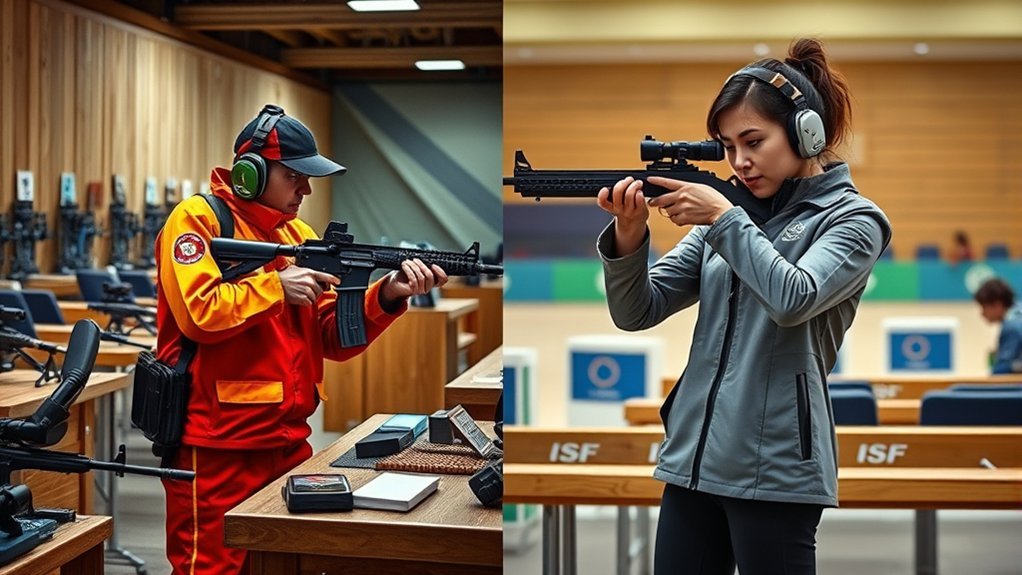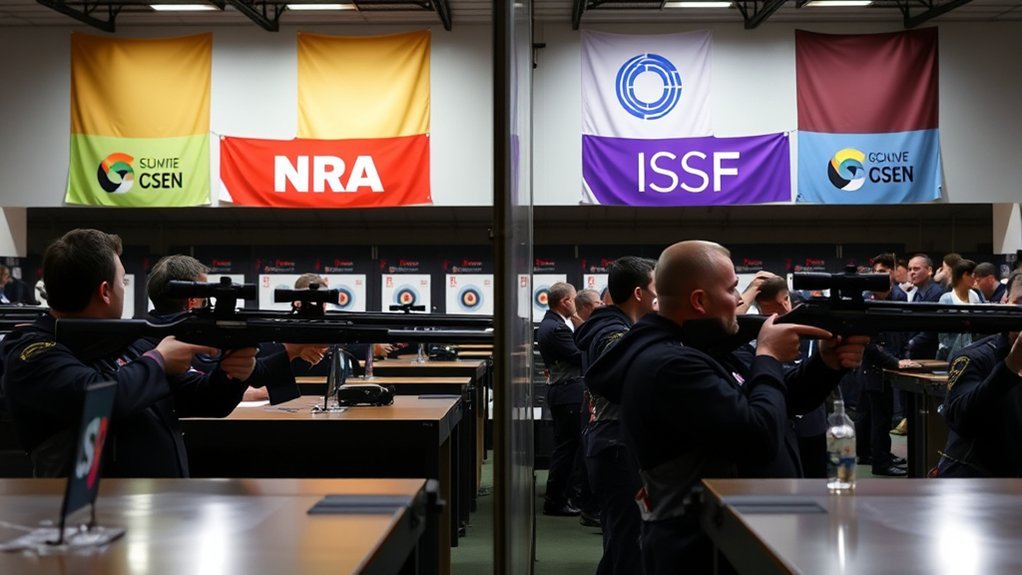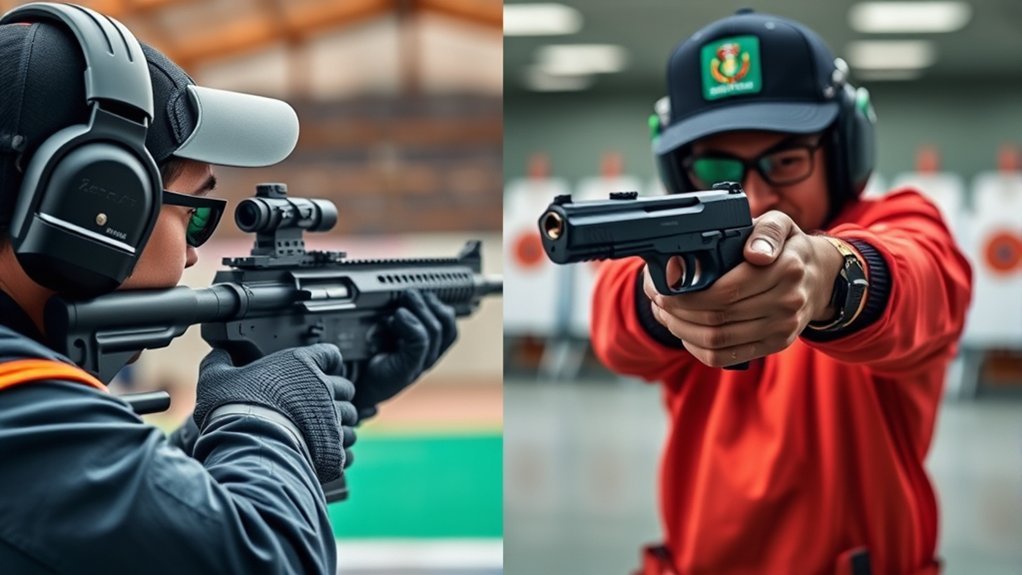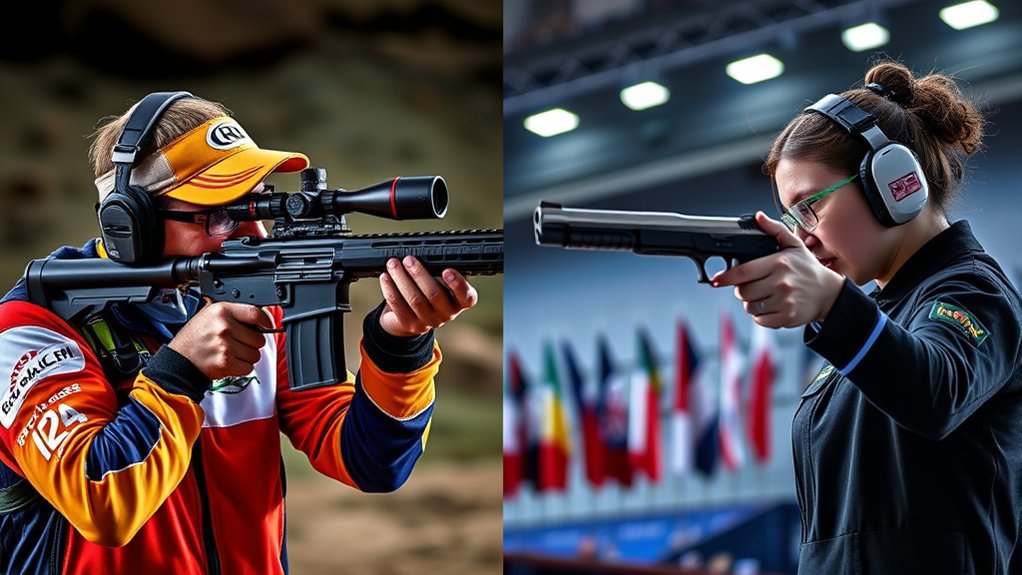Did you know that the NRA and ISSF competitions offer unique experiences tailored to different shooting styles? Each organization has its own approach, emphasizing various skills and techniques that can enhance your performance. As you explore their competition formats, you’ll notice distinct rules, scoring systems, and equipment regulations that set them apart. Understanding these differences could greatly impact your training and competitive strategies, so let’s break down what each has to offer.
Overview of NRA Competitions

When you plunge into NRA competitions, you’ll discover a range of formats designed to test various shooting skills. From precision shooting to action shooting, each discipline challenges you in unique ways. You can participate in events like High Power Rifle, where accuracy at long distances is key, or the fast-paced, dynamic environment of the NRA Action Pistol, which emphasizes speed and quick decision-making. You’ll also find silhouette shooting, where you aim at metal animal targets, testing both your precision and timing. Additionally, there are opportunities for both individual and team competitions, providing a community aspect to the experience. Each format is designed to enhance your shooting proficiency while encouraging camaraderie among participants. Embrace the challenge and improve your skills!
Overview of ISSF Competitions

When you explore ISSF competitions, you’ll encounter a variety of event types and formats designed to test shooters’ skills across different disciplines. Understanding the scoring and judging systems is essential, as they play a significant role in determining rankings and outcomes. Let’s break down what makes ISSF competitions unique and how they differ from others.
Event Types and Formats
The International Shooting Sport Federation (ISSF) hosts a variety of competitions that showcase different shooting disciplines, each with its unique format and rules. Understanding these formats is essential for athletes and spectators alike. Here are four key event types you’ll encounter:
- Rifle Events: Competing at distances of 10m, 50m, and 300m across various positions.
- Pistol Events: Featuring precision shooting at 10m and rapid-fire events at 25m.
- Shotgun Events: Including trap, skeet, and double trap, focusing on hitting flying targets.
- Mixed Team Events: A modern addition where male and female athletes compete together, promoting inclusivity.
These diverse formats not only test skill and precision but also enhance the excitement of competitive shooting.
Scoring and Judging Systems
Understanding the formats of ISSF competitions naturally leads to exploring how scoring and judging work within these events. In ISSF competitions, shooters aim for precision, and scores reflect their accuracy. Each shot is evaluated on a scale, with higher scores indicating better performance.
Here’s a quick overview of the scoring system:
| Score Range | Description |
|---|---|
| 10.0 – 9.0 | Excellent Accuracy |
| 8.9 – 7.0 | Good Performance |
| 6.9 – 5.0 | Average Accuracy |
| Below 5.0 | Below Standard |
Judges guarantee fairness, using electronic scoring systems to minimize errors. Competitors must familiarize themselves with these systems to excel in their events.
Different Shooting Disciplines

When it comes to shooting disciplines, you’ll find a variety of formats that cater to different skills and preferences. Olympic events showcase the highest level of competition, while NRA formats offer unique challenges suited for a wide range of shooters. Understanding the target types and distances involved can help you appreciate the nuances of each discipline.
Olympic Shooting Events
While exploring Olympic shooting events, you’ll discover a diverse range of disciplines that showcase the precision and skill of athletes. These events are designed to test various shooting techniques and abilities:
- Rifle Events: Competitors shoot at small targets from various distances, emphasizing stability and control.
- Pistol Events: Athletes fire at targets using handguns, focusing on accuracy and quick response.
- Shotgun Events: Participants aim at clay targets launched into the air, requiring reflexes and timing.
- Mixed Team Events: These involve male and female athletes competing together, promoting inclusivity and teamwork.
Each discipline requires unique training and mental focus, making Olympic shooting a fascinating blend of sport and precision.
NRA Competitive Formats
The National Rifle Association (NRA) offers a variety of competitive formats that cater to different shooting disciplines, reflecting the organization’s commitment to promoting shooting sports. You’ll find formats for rifle, pistol, and shotgun, each with distinct rules and requirements. In rifle competitions, you can engage in precision shooting or high-power events, which test your accuracy and skill. Pistol formats include both bullseye and action shooting, demanding quick decision-making and precision under pressure. Shotgun disciplines, such as trap, skeet, and sporting clays, challenge your ability to hit moving targets. Each format encourages shooters of all skill levels to participate, fostering a strong community while improving marksmanship and safety in the shooting sports arena.
Target Types and Distances
In various shooting disciplines, understanding target types and distances is essential for honing your skills. Different competitions require you to adapt to specific targets and their placements, which can greatly influence your performance. Here are four key aspects to evaluate:
- Target Types: You might encounter paper, metal, or electronic targets, each requiring different techniques.
- Distances: Distances can vary widely; for example, precision shooting often requires longer ranges.
- Target Size: The size of the target can affect your focus and aiming strategy.
- Shooting Position: Different positions (standing, kneeling, prone) can alter your approach to both timing and accuracy.
Scoring Systems and Rules
Understanding the scoring systems and rules in shooting competitions can greatly enhance your appreciation for the nuances of the sport. In both NRA and ISSF formats, accuracy is paramount, with points awarded based on shot placement. The ISSF typically uses a decimal scoring system, allowing for more precise measurements, while the NRA may utilize a ring-based system, where each ring corresponds to a set point value.
Rules around shooting time, number of shots, and tie-breaking procedures can differ. For instance, ISSF mandates specific time limits for shot execution. Familiarizing yourself with these regulations not only helps you grasp the competition’s flow but also deepens your understanding of how shooters strategize for peak performance.
Equipment Regulations
When competing in shooting sports, equipment regulations play a significant role in ensuring fair play and uniformity among participants. Both the NRA and ISSF have specific guidelines that you need to follow. Here are some key points to reflect on:
- Firearms: Each organization specifies the types of firearms allowed, including caliber and weight restrictions.
- Ammunition: Regulations dictate the kind of ammunition you can use, ensuring consistency in performance.
- Protective Gear: You must wear appropriate safety gear, such as eye and ear protection, to maintain safety standards.
- Clothing: Certain clothing guidelines exist to promote fairness, including restrictions on materials that could enhance performance.
Familiarizing yourself with these regulations is essential for a successful competition experience.
Training and Preparation Strategies
Effective training and preparation strategies can greatly enhance your performance in shooting competitions. Start by establishing a consistent practice schedule that includes both dry firing and live shooting sessions. Focus on your fundamentals, such as grip, stance, and trigger control, as these are essential for accuracy. Incorporate mental training techniques, like visualization and mindfulness, to boost your concentration under pressure.
Additionally, analyze your performance through video recordings to identify areas for improvement. Set specific, measurable goals to track your progress and stay motivated. Don’t forget to incorporate physical conditioning; a strong body can improve your endurance and stability during competitions. Finally, simulate competition conditions in your training to familiarize yourself with the pressure, ensuring you’re prepared on competition day.
Conclusion
In the world of shooting sports, choosing between NRA and ISSF competitions is like selecting a path through a dense forest. Each trail offers unique experiences and challenges, shaping you as a marksman. Whether you’re drawn to the camaraderie of NRA events or the precision of ISSF formats, your journey will deepen your skills and appreciation for the sport. Embrace the adventure, explore both avenues, and let each competition sharpen your aim and broaden your horizons.

